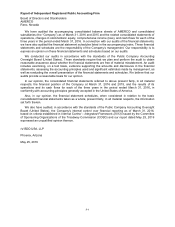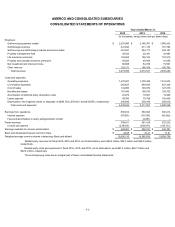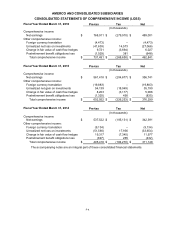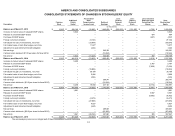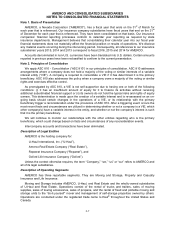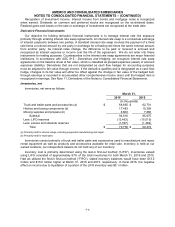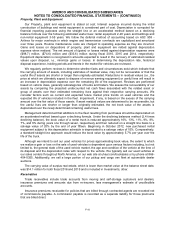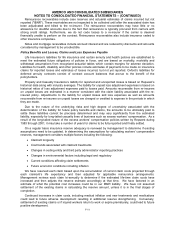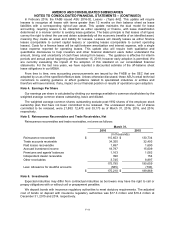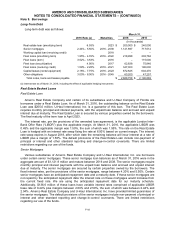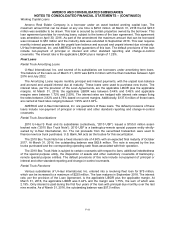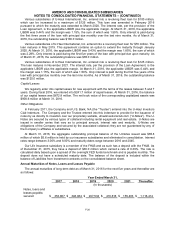U-Haul 2016 Annual Report Download - page 67
Download and view the complete annual report
Please find page 67 of the 2016 U-Haul annual report below. You can navigate through the pages in the report by either clicking on the pages listed below, or by using the keyword search tool below to find specific information within the annual report.AMERCO AND CONSOLIDATED SUBSIDIARIES
NOTES TO CONSOLIDATED FINANCIAL STATEMENTS – (CONTINUED)
F-11
Reinsurance recoverables include case reserves and actuarial estimates of claims incurred but not
reported ("IBNR"). These receivables are not expected to be collected until after the associated claim has
been adjudicated and billed to the re-insurer. The reinsurance recoverables may have little or no
allowance for doubtful accounts due to the fact that reinsurance is typically procured from carriers with
strong credit ratings. Furthermore, we do not cede losses to a re-insurer if the carrier is deemed
financially unable to perform on the contract. Reinsurance recoverables also include insurance ceded to
other insurance companies.
Notes and mortgage receivables include accrued interest and are reduced by discounts and amounts
considered by management to be uncollectible.
Policy Benefits and Losses, Claims and Loss Expenses Payable
Life Insurance’s liabilities for life insurance and certain annuity and health policies are established to
meet the estimated future obligations of policies in force, and are based on mortality, morbidity and
withdrawal assumptions from recognized actuarial tables which contain margins for adverse deviation.
Liabilities for health, disability and other policies include estimates of payments to be made on insurance
claims for reported losses and estimates of losses incurred, but not yet reported. Oxford’s liabilities for
deferred annuity contracts consist of contract account balances that accrue to the benefit of the
policyholders.
Property and Casualty Insurance’s liability for reported and unreported losses is based on Repwest’s
historical data along with industry averages. The liability for unpaid loss adjustment expenses is based on
historical ratios of loss adjustment expenses paid to losses paid. Amounts recoverable from re-insurers
on unpaid losses are estimated in a manner consistent with the claim liability associated with the re-
insured policy. Adjustments to the liability for unpaid losses and loss expenses as well as amounts
recoverable from re-insurers on unpaid losses are charged or credited to expense in the periods in which
they are made.
Due to the nature of the underlying risks and high degree of uncertainty associated with the
determination of the liability for future policy benefits and claims, the amounts to be ultimately paid to
settle these liabilities cannot be precisely determined and may vary significantly from the estimated
liability, especially for long-tailed casualty lines of business such as excess workers’ compensation. As a
result of the long-tailed nature of the excess workers’ compensation policies written by Repwest during
1983 through 2001, it may take a number of years for claims to be fully reported and finally settled.
On a regular basis insurance reserve adequacy is reviewed by management to determine if existing
assumptions need to be updated. In determining the assumptions for calculating workers’ compensation
reserves, management considers multiple factors including the following:
Claimant longevity
Cost trends associated with claimant treatments
Changes in ceding entity and third party administrator reporting practices
Changes in environmental factors including legal and regulatory
Current conditions affecting claim settlements
Future economic conditions including inflation
We have reserved each claim based upon the accumulation of current claim costs projected through
each claimant’s life expectancy and then adjusted for applicable reinsurance arrangements.
Management reviews each claim bi-annually to determine if the estimated life-time claim costs have
increased and then adjusts the reserve estimate accordingly at that time. We have factored in an
estimate of what the potential cost increases could be in our IBNR liability. We have not assumed
settlement of the existing claims in calculating the reserve amount, unless it is in the final stages of
completion.
Continued increases in claim costs, including medical inflation and new treatments and medications
could lead to future adverse development resulting in additional reserve strengthening. Conversely,
settlement of existing claims or if injured workers return to work or expire prematurely, could lead to future
positive development.


